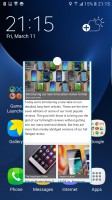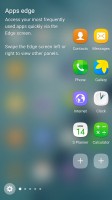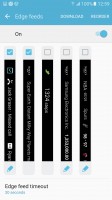Xiaomi Mi Note 2 vs. Samsung Galaxy S7 edge: Bargain bin
Bargain bin

Software
As with packaging, there's little to set apart the flagship-grade Mi Note 2 from just about any other Xiaomi phone. MIUI is remarkably consistent between devices, which isn't a bad thing - there'll be no adjusting if you're switching between Xiaomi phones.
The latest v.8 iteration is based on Marshmallow and is flat and colorful. There's no app drawer - all apps are on the homescreens, as is customary for Chinese Android ROMs. You get theming support with a wide range of themes to download which bring a total makeover, some even have interactive wallpapers. The notification shade and task switcher have no traces of stock Marshmallow, the task switcher looks more like iOS than Android.





Mi Note 2: Lockscreen • Homescreen • Interactive wallpaper • Notification shade • Task switcher
MIUI 8 has also brought Dual apps and Second space. The first feature lets you have two instances of an app, so you can be logged with two accounts at the same time - especially handy for social and IM apps. Second space is an entirely different 'desktop' (if you will), protected with a different fingerprint, where you can have a separate set of apps and keep photos and docs away from prying eyes - we're sure you can come up with a use case.




Dual apps • Any app can be a dual app • Second space • ...and its settings
The Mi Note 2 comes with a full set of tools so you don't need to bother with third-party ad-supported or paid apps. There's a phone manager sort of app called Security, which is a hub for controlling permissions, data usage and battery modes, among other things.
You also get a neat-looking and capable file manager, calendar and compass apps, to name a few. The Music player also has profiles for optimal tuning to match Xiaomi's different headsets.





Security app • File manager • Calendar • Compass • Headphone profiles
The Galaxy S7 edge interface is similarly non-vanilla, though less of a deviation from Google's Android. For one, it's two-tiered - there's an app drawer, where all your apps sit, and homescreens with shortcuts to them. Themes are supported too.
The notification area with quick toggles is custom too, just a different type of 'custom'. The task switcher, on the other hand, is much closer to the standard Android rolodex than the one found in MIUI.





Galaxy S7 edge: Lockscreen • Homescreen • Themed homescreen • Notification shade • Task switcher
With the S7 and S7 edge Samsung introduced an Always on display (AOD) feature. Basically, you can have one of several clock designs displayed constantly on the screen, and if a notification comes in, an icon pops up underneath the clock - in a quick glance you can see the time, battery percentage and pending notifications. You can add a calendar or one of a few background images.
Also debuting on the S7 edge was Samsung's Game launcher - an app that holds shortcuts to your favorite games, but more importantly can lock the capacitive keys to prevent accidental touches and can also keep non-essential notifications from interrupting your gaming.
Samsung has also been pushing multi-window multitasking since before it was cool (it's now part of stock Nougat) and the S7 edge has that as well. You can have a windowed view of most apps, if that's your thing.





Game launcher • Multi-window • Browser in a window
Being an 'edge' device the S7 edge has 'edge' features as well. Originating in the Note Edge of old, but expanded on subsequent models, the edge panes now include Apps edge (shortcuts to apps of your choosing), Quick tools (for when opening a full-fledged app is too cumbersome), People edge (shortcuts to contacts), Edge feeds - it's had to even list them all. Oh, there's also Night clock (self explanatory, no?), and Edge lighting if for some reason you like to keep your precious phone face down on a table.
Cheaper, but just as good: Different - certainly, as good - not really. Both phones run heavily customized Android builds, neither has the latest OS version. The S7 edge has Game launcher, Always on display, and does offer edge features to showcase that curved display, unlike the Mi Note 2.
Performance
The Galaxy S7 edge was released a long, long time ago in the spring and back then it was the Snapdragon 820 that ruled the world of smartphone chipsets. Well, that and the Exynos 8890, one of which can be found in different versions of the Samsung top-dog.
The Mi Note 2, on the other hand, is packing the updated Snapdragon 821 SoC which comes with a higher clocked CPU 2.35GHz vs 2.15GHz for one of the two Kryo pairs. The Mi Note 2 can be had with 6GB of RAM, but the version we've tested had 4GB, same as both S7 edges.
In dedicated CPU benchmarks, specifically GeekBench 4, the Mi Note 2 ranks between the two S7 edge versions. In single-core tests it scores almost as much as the Exynos-powered S7 edge, both of them leaving the S820 behind. Putting more cores to work changes the numbers, but not the ranking - Exynos is king, but the S821 in the Mi Note 2 is now closer to the S820 S7 edge.
GeekBench 4 (single-core)
Higher is better
-
Samsung Galaxy S7 edge (E8890)
1860 -
Xiaomi Mi Note 2
1824 -
Samsung Galaxy S7 edge (S820)
1696
GeekBench 4 (multi-core)
Higher is better
-
Samsung Galaxy S7 edge (E8890)
5583 -
Xiaomi Mi Note 2
4278 -
Samsung Galaxy S7 edge (S820)
4128
In compound benchmarks the Mi Note 2 tends to outperform both S7 edges. In Basemark OS II 2.0 it edges ahead of the S820 S7 edge, and both post way higher numbers than the Exynos version of the S7 edge.
Basemark OS 2.0
Higher is better
-
Xiaomi Mi Note 2
2381 -
Samsung Galaxy S7 edge (S820)
2352 -
Samsung Galaxy S7 edge (E8890)
2050
Antutu 6 puts the two Samsung phones somewhat closer together, while the Mi Note 2 leads by a wider margin.
AnTuTu 6
Higher is better
-
Xiaomi Mi Note 2
140324 -
Samsung Galaxy S7 edge (S820)
132849 -
Samsung Galaxy S7 edge (E8890)
129229
In graphics benchmarks we witness the expected huge gap in framerates between the Mi Note 2 and the S7 edge, as the Samsung phablet has a lot more pixels to render - 78% more, to be precise. In GFXBench 3.1 the Mi Note 2 is capable of double the framerate the S7 edge can put out, be it the Adreno 530 in the S820 or the Mali-T880 in the Exynos 8890. In the less taxing GFXBench 3.0 the difference is smaller, to the tune of 50%.
GFX 3.0 Manhattan (1080p offscreen)
Higher is better
-
Samsung Galaxy S7 edge (S820)
49 -
Xiaomi Mi Note 2
40 -
Samsung Galaxy S7 edge (E8890)
40
GFX 3.0 Manhattan (onscreen)
Higher is better
-
Xiaomi Mi Note 2
41 -
Samsung Galaxy S7 edge (S820)
29 -
Samsung Galaxy S7 edge (E8890)
27
GFX 3.1 Manhattan (1080p offscreen)
Higher is better
-
Samsung Galaxy S7 edge (S820)
32 -
Xiaomi Mi Note 2
30 -
Samsung Galaxy S7 edge (E8890)
29
GFX 3.1 Manhattan (onscreen)
Higher is better
-
Xiaomi Mi Note 2
30 -
Samsung Galaxy S7 edge (S820)
16 -
Samsung Galaxy S7 edge (E8890)
15
Cheaper, but just as good: Often better. The Snapdragon 821 in the Xiaomi Mi Note 2 outperforms both versions of the Galaxy S7 edge in most tests.
Loudspeaker & audio quality
Both smartphones have a single loudspeaker on the bottom, so no stereo action on either one. They aren't overly loud either, but still manage a Good rating in our three-pronged test.
| Speakerphone test | Voice, dB | Ringing | Overall score | |
| 63.4 | 68.6 | 76.4 | Good | |
| 70.0 | 69.1 | 71.8 | Good |
As for audio quality through the 3.5mm jack, the Mi Note 2 has a minor edge in terms of noise, while the S7 edge is marginally better in channel separation. The Mi Note 2 is also very loud compared to the just above average S7 edge.
Plugging in a pair of headphones adversely affects the Mi Note 2's output introducing significant stereo crosstalk, while the S7 edge happily handles the load with only the slightest bump in crosstalk.
| Test | Frequency response | Noise level | Dynamic range | THD | IMD + Noise | Stereo crosstalk |
| +0.00, -0.03 | -94.4 | 94.5 | 0.0014 | 0.0062 | -91.7 | |
| +0.29, -0.34 | -94.5 | 94.0 | 0.028 | 0.417 | -51.9 | |
| Samsung Galaxy S7 edge | +0.01, -0.05 | -92.5 | 92.7 | 0.0028 | 0.0089 | -92.2 |
| Samsung Galaxy S7 edge (headphones) | +0.02, -0.06 | -92.0 | 92.0 | 0.0052 | 0.092 | -85.2 |
Cheaper, but just as good: Pretty much. The Mi Note 2 matches the S7 edge in loudspeaker volume, and the two trade victories in different areas of audio quality.
Reader comments
- Irtiza A.
- 16 Dec 2021
- bJ9
nope galaxy note edge was the first in 2014
- Anonymous
- 18 Jan 2017
- gNT
Get your facts correctly. Xiaomi was the brand that started the curve display first with its mi note. Mi note 2 is built on that platform.
- AnonD-608498
- 17 Jan 2017
- PxI
True a typo, but as you know I meant the 7 and the point remains the same.









